How does the Chivito Uruguayo stack up?
We’re off, today, to the República Oriental del Uruguay, or, just Uruguay. Probably about a decade ago I got into an online “discussion” with an NYU student spending a year abroad in Argentina, who, in a misguided, early woke attempt, went into an online rant about the racism of the white people of Argentina, who were, in the early 21st century, using the clearly offensive word “oriental”. His feverish, and performative angst headed into the realm of “Asian people don’t look like indigenous people of Latin America”, and on into “Not all Asians look alike”. An attempt to explain to him that in Spanish, oriental simply means eastern, and that Uruguay named itself, Argentina didn’t, fell on pre-closed ears. He was right, all white people were wrong and racists, and that was that. Shades of many an online discussion these days, though I’ve tried to learn not to engage anymore.
In the gastronomic world of Uruguay, there is a sandwich. It’s a steak sandwich. One finds steak sandwiches the world over, so not all that unusual on that front. And in its most simple form, not all that different from any other.
Our story originates on New Year’s Eve 1944. As the regulars of El Mejillón Bar in Punta del Este, on the eastern (oriental?) shore of the country prepared for midnight celebrations, one asked the owner for some chivo, goat meat, popular in these parts back in the day (and, still found in some parrillas). Not having any, the owner and chef decided to simply slice some steak extra thin, grill it, heavily season it, and top it with classic sandwich toppings – lettuce, tomato, onion, mayo – and just tell the customer it was a chivito (baby goat) sandwich.
It caught on, and owner Antonio Carbonaro found himself selling dozens, then hundreds, and over the course of a couple of years, turned his business into one selling over a thousand chivitos a day. He also started sprucing them up – adding more toppings. These days, a “simple” chivito uruguayo will be topped with ham or bacon, cheese, lettuce, tomato, onion, pickles, and olives, and sometimes more. A variation called a chivito canadiense replaces the ham or bacon with Canadian bacon, or at least the local facsimile of it.
Over my years here, I’ve visited Uruguay many a time, and I try to always sample at least one or two chivitos wherever I am. It’s a shame I missed out on trying one from El Mejillón, which closed a few years back after having been open since 1939. Punta del Este is not generally my first destination in Uruguay – most of my time has been spent in Colonia del Sacramento on the west coast, just across the river from Buenos Aires, or in the capital, Montevideo.
My very first chivito, back in 2006, pretty much remains my favorite. That may not be a surprise, given that I had been invited by the national wine institute and ministry of tourism to attend Uruguay’s national “best chef” competition in Punta del Este. Not to compete or judge, but to write about it. After a somewhat tedious day, where I quickly found that this was more of a “best of young cooks who might one day be worthy of being considered top chefs competition”, my chaperone, José Luis, asked if I wanted to go out to dinner.
When asked if there was anything in particular I wanted to try, I opined that I didn’t want a big steak, or fancy dinner, but something simple and classic. He asked if I’d ever had a chivito uruguayo, and when I said no, he asked if I minded a two hour wait for dinner, to head to the best place in the entire country for one, in his opinion. Though edging into hungry, it wasn’t that late, and we hopped in his car and sped off to the west, back to Montevideo. Here, he took me to the original (I think) branch of a four-shop chain, Chiviteria Marcos, Av. Luis Alberto de Herrera 1186 in the Nuevo Pocitos neighborhood. Post-pandemic, this is the only remaining one.
My thoughts at the time: “A chivito is a sandwich that Dagwood would envy. A thin slice of steak is tossed on the grill and browned on both sides. It is then topped with a slice of smoked ham. This is placed on top of lettuce and tomato on a bun. It is then topped off with your choice from an array of toppings – olives, pickled peppers, pickled vegetables, onions, red bell pepper, mushrooms, hard-boiled egg – and a choice of different mayonnaise based sauces. I took mine with a little of everything, and then topped it off with salsa golf (basically, ketchup and mayonnaise mixed). Then several slices of mozzarella are laid across the whole thing and it’s stuck under the broiler until bubbly and slightly browned. The top of the bun is slapped on top and it’s stuck on a plate in front of you.”
Other than having used the word “topped” way too many times, what’s not to like about that? I’m not going to review every chivito I’ve ever tried, just the ones I think are worth recommending.
Montevideo
The capital of Uruguay boasts about 1.4 million of Uruguay’s 3.4 million inhabitants. It’s really the only city of size in the country – the next biggest city is Salto, in the northwest of the country, with a population that just squeaks out to 104,000. Located on the south central shore of Uruguay, it looks out over what appears to be the Atlantic, but the roiling, brown-blue water, filled with silt, belies that. And in fact the Rio de la Plata’s delta at this point is 173km (107 miles) across and this is freshwater. The river doesn’t end, changing to the saltwater of the ocean, until a line drawn between Punta del Este, a two hour car ride east, and Cabo San Antonio, Argentina, on the east coast, where it is 220km (137 miles) across.
I’m going to start with a more recent revisit to Chiviteria Marcos, and a better photo of what the insides of this whopping sandwich involves. I was with a friend, and we were out to try our way through several versions, but after splitting this and one more, gave up. These days, a good chivito at most places in town, run anywhere from 450-700 uruguayos, a big range from $11.50-18. Uruguay is noticeably more expensive than Argentina, and has been for a very long time. By the way, all of these come with fries on the side, or on the plate, depending on the place, I just don’t have photos that necessarily include them.
One spot that comes up on list after list is the well known and very popular El Tinkal, Dr Emilio Frugoni 853, on the waterfront in barrio Palermo. Here, the sandwich is much more basic – their “completo” features the steak, bacon, tomato, lettuce, mozzarella (underneath, here, rather than browned atop), green olives, and mayo. Simpler than the above, but absolutely delicious, and for many people, they like it because it doesn’t have all the toppings that may detract from the star of the show, the meat.
I’m going to say I was quite surprised at this one. La Pasiva is a national chain in Uruguay, with locations everywhere (this one at Blvr. Juan Benito Blanco 920, in the Pocitos neighborhood. My first encounter with them was in Colonia del Sacramento, and by way of comparison, this is what the chivitos looked like there (looked, because the one branch in Colonia closed up during the pandemic and never reopened). That’s the first picture above, a whopping sandwich filled with tasty stuff, much like the Marcos version. But the ones in Montevideo, at least the ones I’ve seen, all seem much more diner/fast food style, and while this was a perfectly acceptable sandwich, it doesn’t hold a candle to the place in Colonia. I’m of the belief that if you put a fried egg on a sandwich, it should have a runny yolk. This one doesn’t. And it sticks with the simple model, albeit well-seasoned, it’s steak, ham, cheese, lettuce, tomato, and mayo.
Right across the street is another highly recommended spot, Expreso Pocitos, Blvr. Juan Benito Blanco 956. It’s much the same as the one on the other side of the boulevard, just featuring sliced hard-boiled egg instead of a fried one. Better fries, and a better bun. Still, the two are kind of a toss-up. Were the one at La Pasiva more like the version they served in Colonia, it’d be the hands-down winner in the ‘hood.
This one came from a local Montevideo food blogger, who wrote up his seven favorite restaurants in the city, from casual to fancy, and for the casual end, went with Bar Montevideo al Sur, Paraguay 1150 in Barrio Sur. Perhaps most distinctive about this one is the bread, which is almost more of a baguette style – not in form, but it has the slightly crunchy crust and a chewier interior. The sandwich, excellent, with steak, bacon, cheese, bell pepper, lettuce, tomato, and a properly fried egg this time. And, I really like the place, it has an old-timey bar feel to it. Excellent empanadas too, though four on a plate is a bit much for an appetizer, unless you have someone to share them with.
The one spot I didn’t get to on my most recent trip was Bar Arocena. It just didn’t fit in with my schedule, and it’s out to the far east of the city in the Carrasco neighborhood. I gather that, in fitting with other restaurants in the immediate area, it’s pretty upscale, and they’ve gone an upscale route with the sandwich as well. I look forward to trying it on a future trip.
Colonia del Sacramento
Colonia is one of those places that a lot of visitors and expats go to. The former, often just to check off a bucket list of having made it to another country, the latter, it’s a way for those of us (not me any longer) who only have a tourist visa to renew it for another 90 days. A quick ferry ride (50 minutes) across the river, have lunch, and come back. But these days, the ferry’s getting a bit pricier, and the immigration folk have, at times, started to crackdown on people who keep extending their visa this way. That actually happened to me about 12 years ago, at which point I applied for and got permanent residency (not citizenship, more like a US green card). The town has a mere 27,000 inhabitants.
Although a really stacked chivito tends to come from a restaurant, there are street food versions of them, and it’s not uncommon to grab one to snack on. They tend to be smaller and simpler, but can be very satisfying. As best I can tell, Everyone knows that the best in town are from Carrito Los Farolitos, Gral. Flores 252 (approximately, it’s a cart on the street), in the downtown area. This one comes with steak, bacon and ham(!), cheese, fried egg, and your choice of sauces. A snack not to be missed.
Now, I was going to do a writeup of a quartet of favorite chivitos in Colonia. I haven’t been since the pandemic, and it turns out that three of the four closed up and didn’t reopen. Taps music for the demise of La Pasiva, Dunbar, and San Cono. You already saw the first’s version above, here are the other two:
If you’re traveling to Uruguay, and I guess given the actual spots I’ve tried, particularly to Montevideo, don’t miss out on this classic sandwich. Personally, I’d go straight to Marcos, order it up with more or less everything on it, get a bottle of a local beer, and eat yourself into a food coma.
Buenos Aires
Not everyone is going to make it across the river to Uruguay from here in Buenos Aires, and there are places that offer up chivitos. I’ve tried quite a few, and for me, there’s only one place that really does it up right.
Easily winning out is the version from La Perlita, Av. Jujuy 74, kitty-korner from the Once train station. This one is a lot more meat-packed than the typical Uruguayan one – with steak, ham, and Canadian bacon, egg, lettuce, tomato, onion, pickles, olives, palm hearts, and a lot of cheese, both inside the sandwich and melted over the top.
Oh, I should mention that most places, at least the more sit-down restaurant style, offer chivitos either al pan, in bread, the sandwich I’ve been talking about, or al plato, which is without the bread, usually a bigger portion of the various things that go inside the sandwich, and instead of fries, almost always accompanied by ensalada rusa – the local mayo-based potato salad with carrots and peas.
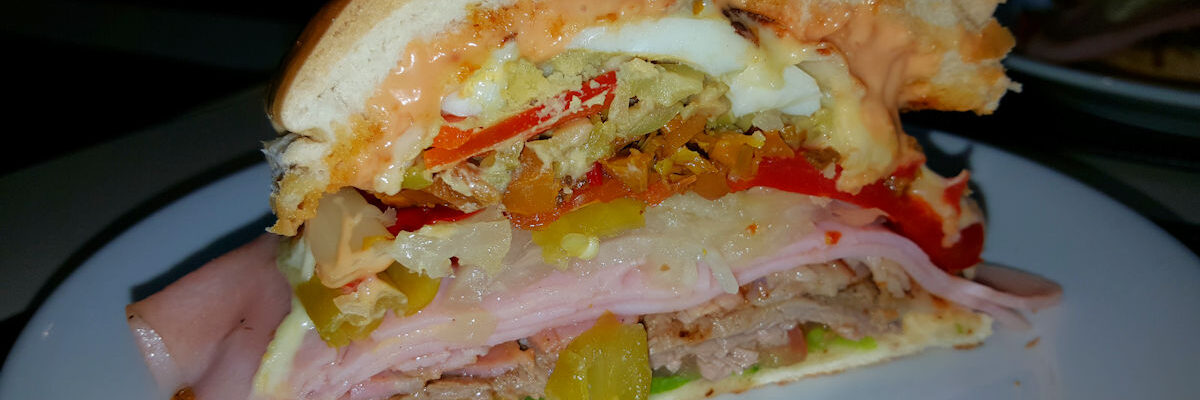
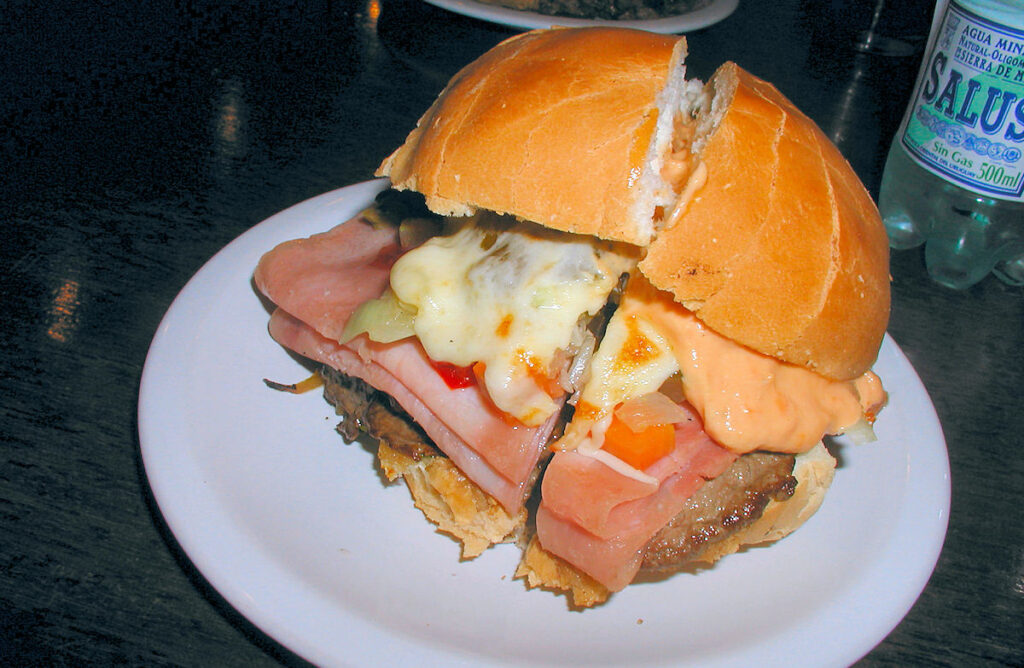
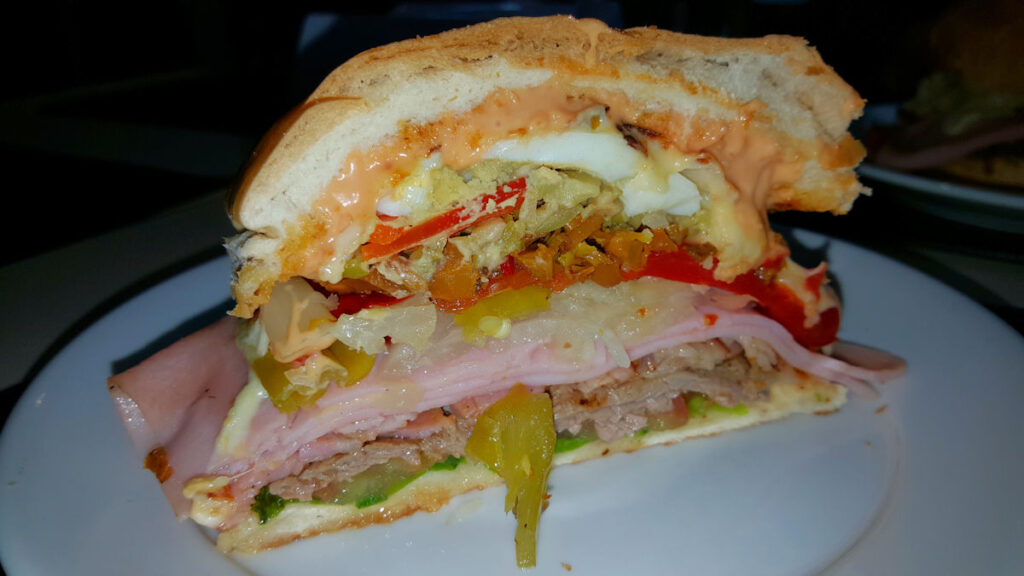
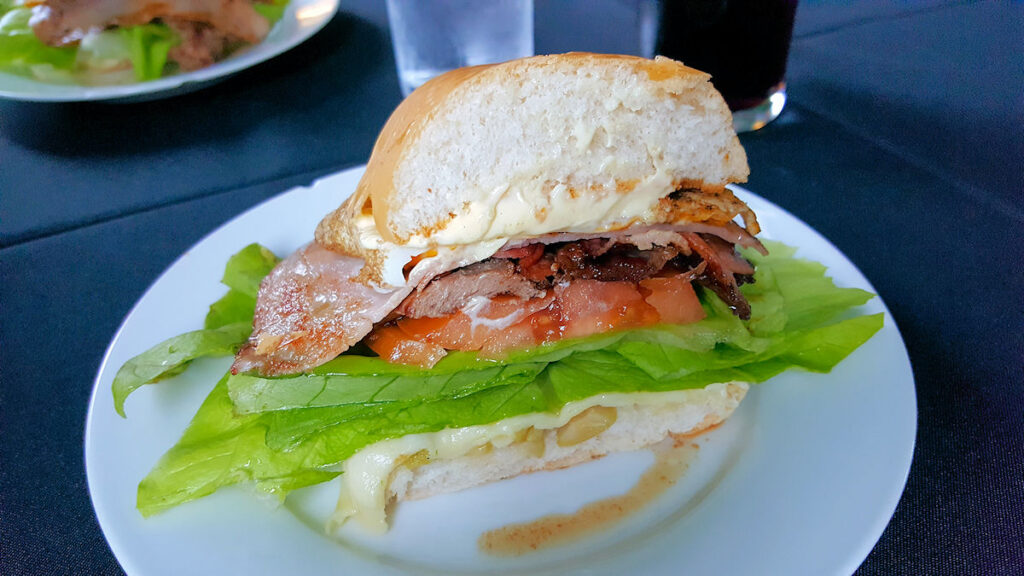
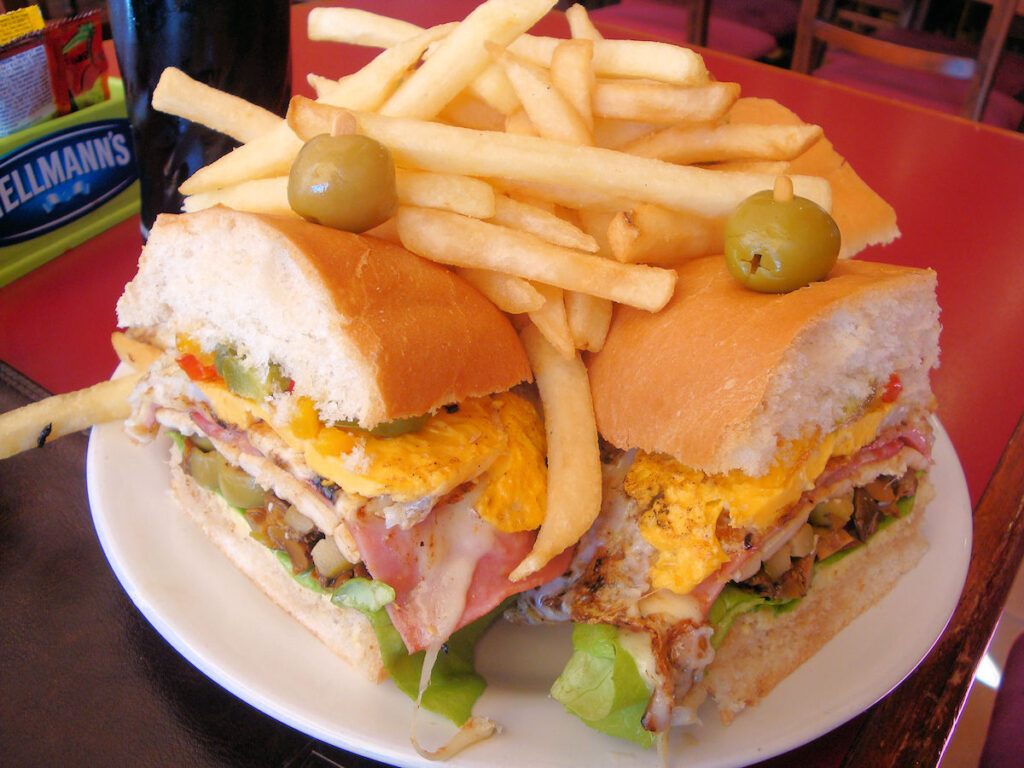
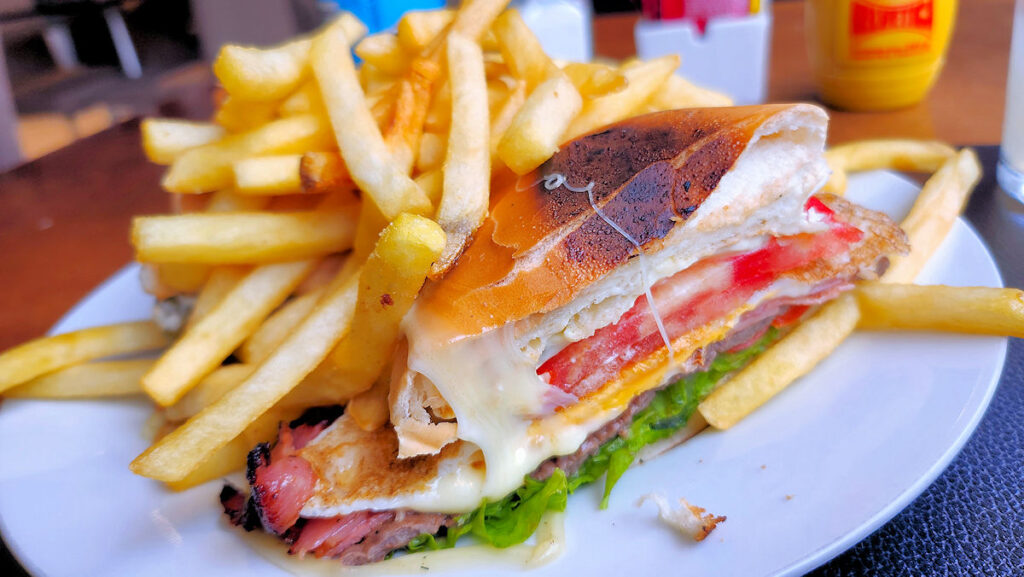
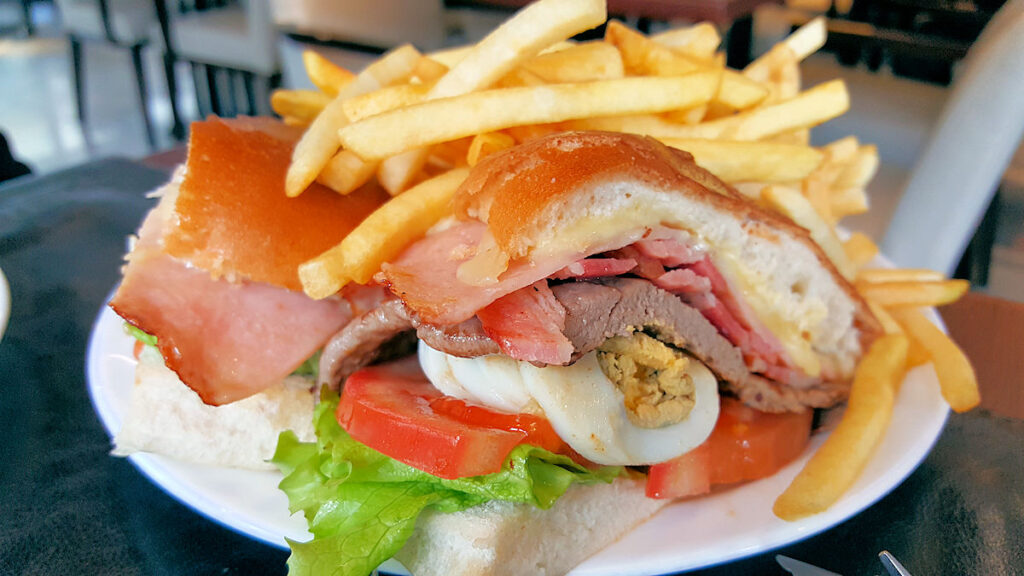
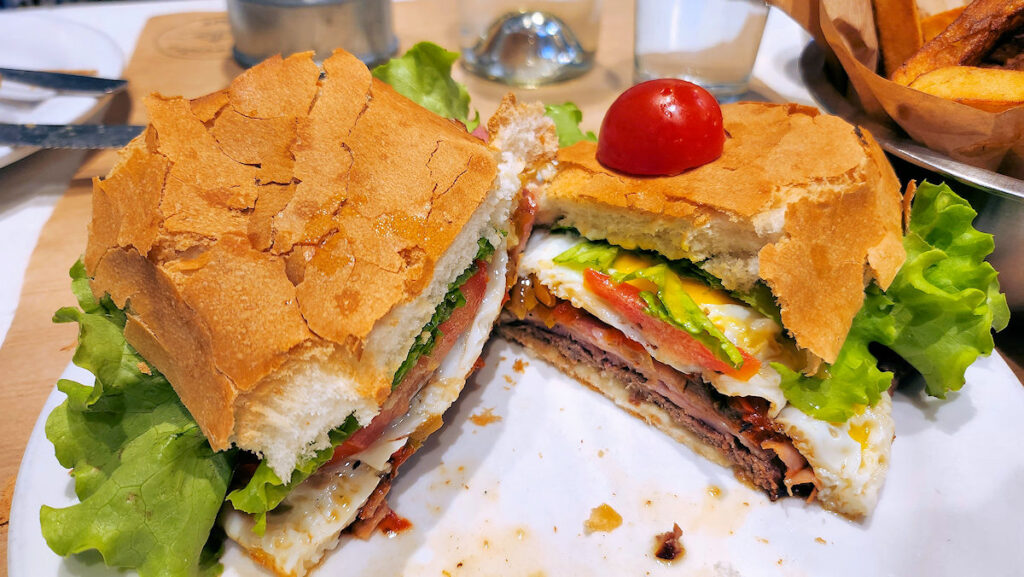
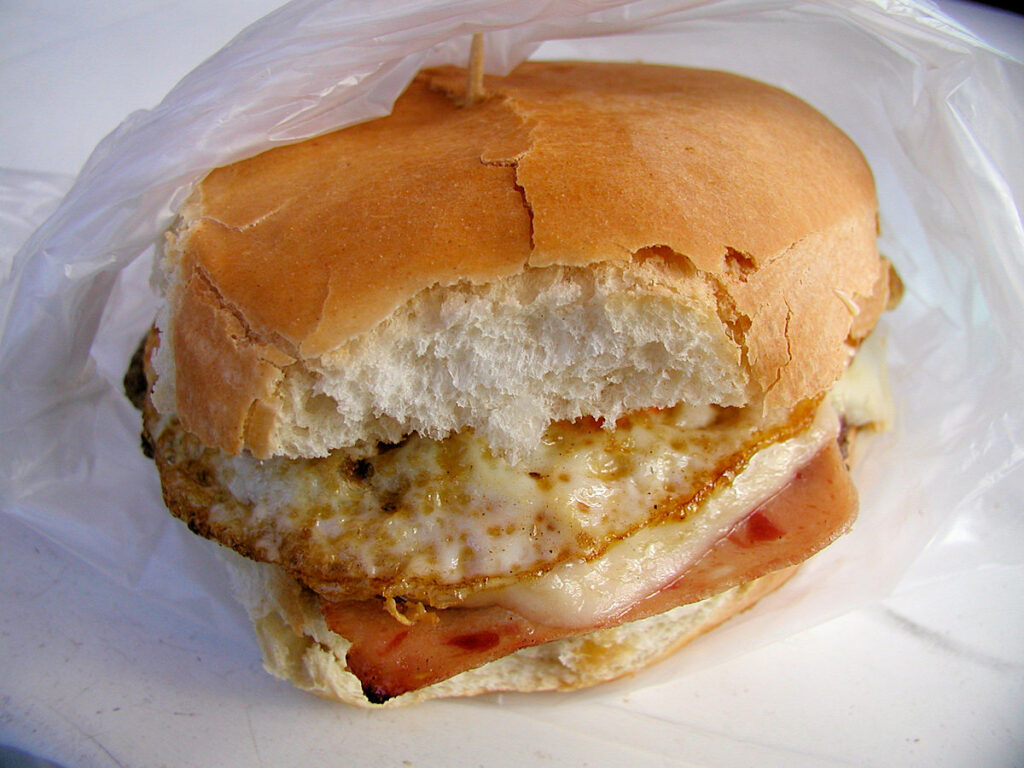
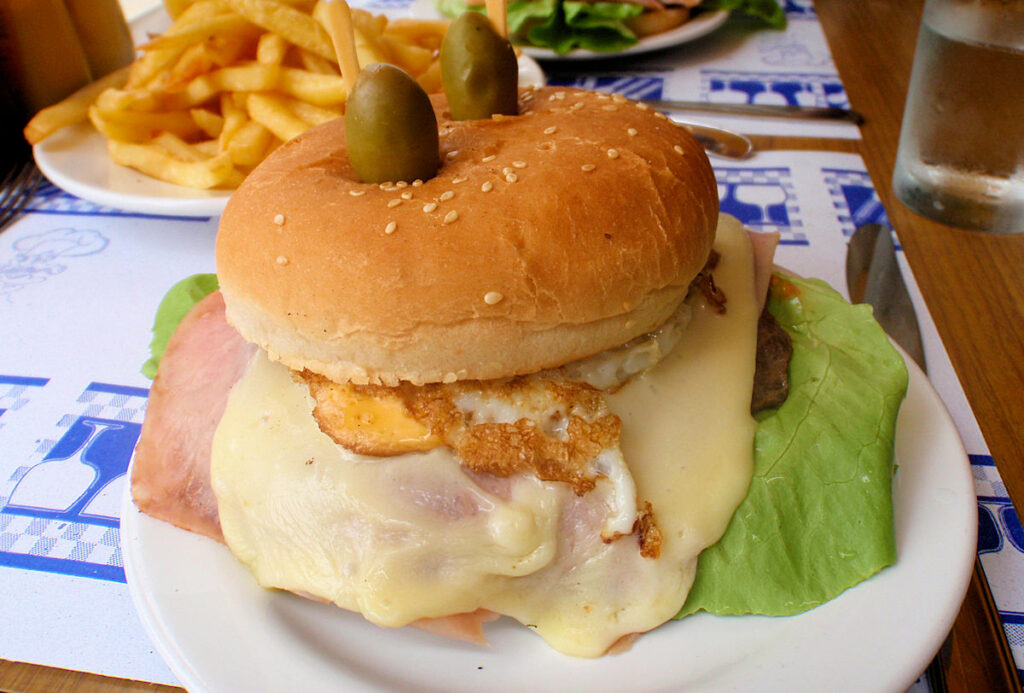
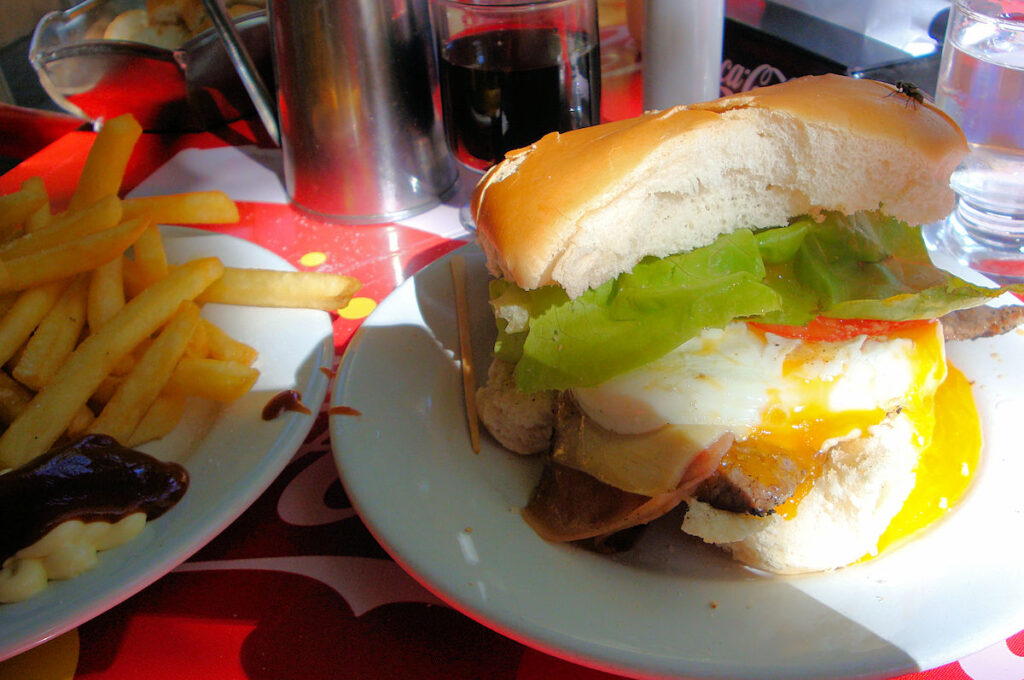
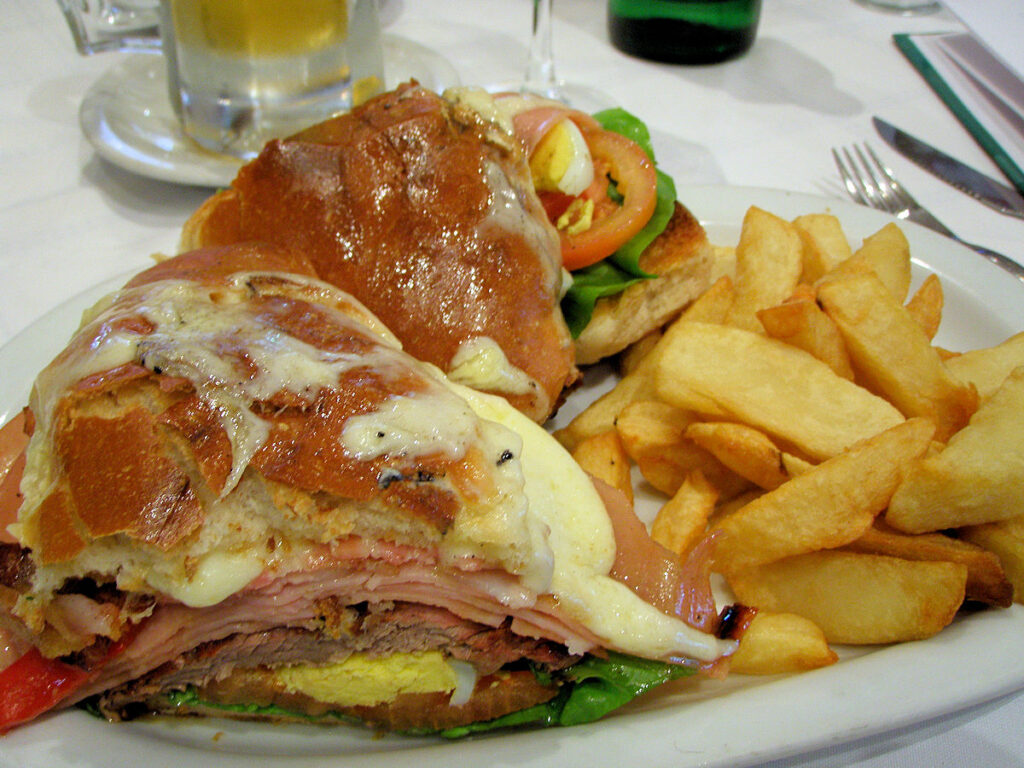
[…] most of the time. Luckily, I don’t mind checking out restaurants, you know? I already covered a couple of new chivito uruguayos in a post a few days ago, along with exploring one of my favorite sandwiches a little more broadly. […]